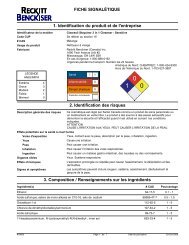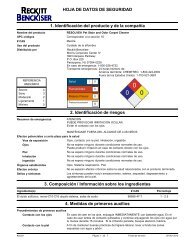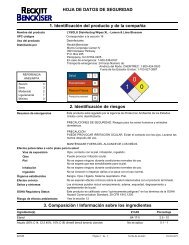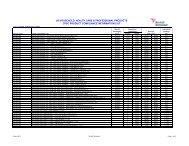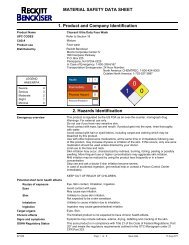BRASSO METAL POLISH.pdf - MSDS
BRASSO METAL POLISH.pdf - MSDS
BRASSO METAL POLISH.pdf - MSDS
You also want an ePaper? Increase the reach of your titles
YUMPU automatically turns print PDFs into web optimized ePapers that Google loves.
.<br />
.<br />
MATERIAL SAFETY DATA SHEET<br />
space<br />
Product Name<br />
space<br />
CAS #<br />
space<br />
1. Product and Company Identification<br />
<strong>BRASSO</strong>® Metal Polish<br />
Mixture<br />
This <strong>MSDS</strong> is not applicable for consumer use of our products. For consumer use, all<br />
precautionary and first aid language is provided on the product label in accordance with<br />
the applicable government regulation.<br />
This <strong>MSDS</strong> is designed for workplace employees, emergency personnel and for other<br />
conditions and situations where there is a greater potential for large-scale or prolonged<br />
exposure, in accordance with requirements of the Canadian Workplace Hazardous<br />
Materials Information System (WHMIS).<br />
Product Use<br />
space<br />
Distributed by<br />
space<br />
LEGEND<br />
HMIS/NFPA<br />
Severe<br />
Serious<br />
4<br />
3<br />
Moderate 2<br />
Slight 1<br />
Minimal 0<br />
space<br />
Emergency Overview<br />
Metal Polish<br />
Reckitt Benckiser (Canada) Inc.<br />
1680 Tech Avenue Unit #2<br />
Mississauga, ON L4W 5S9<br />
In Case of Emergency: 1-800-338-6167<br />
Transportation Emergencies: 24 Hour Number:<br />
North America: CHEMTREC: 1-800-424-9300<br />
Outside North America: 1-703-527-3887<br />
Health / 1<br />
Flammability 2<br />
Physical Hazard 0<br />
Personal Protection<br />
B<br />
2. Hazards Identification<br />
CAUTION<br />
MAY IRRITATE EYES AND SKIN.<br />
2<br />
1 0<br />
space<br />
Potential short term health effects<br />
Routes of exposure<br />
space<br />
space<br />
space<br />
Eyes<br />
Skin<br />
Inhalation<br />
space<br />
Ingestion<br />
space<br />
Target organs<br />
space<br />
Chronic effects<br />
space<br />
Signs and symptoms<br />
space<br />
Potential environmental effects<br />
Keep out of reach of children.<br />
Eye, Skin contact, Inhalation, Ingestion.<br />
May cause eye irritation.<br />
Avoid eye contact.<br />
May cause skin irritation. Not expected to be a skin sensitizer.<br />
Avoid skin contact.<br />
None expected during normal conditions of use.<br />
Health injuries are not known or expected under normal use.<br />
Blood. Eyes. Liver. Respiratory system. Skin.<br />
The finished product is not expected to have chronic health effects.<br />
Symptoms may include redness, oedema, drying, defatting and cracking of the skin.<br />
Symptoms of overexposure may be headache, dizziness, tiredness, nausea and<br />
vomiting.<br />
Components of this product have been identified as having potential<br />
environmental concerns.<br />
#19558 Page 1 of 7 Issue date 19-Dec-2012
.<br />
.<br />
.<br />
.<br />
3. Composition/Information on Ingredients<br />
space<br />
Ingredient(s)<br />
Ethanol<br />
Oxalic acid<br />
Isopropanol<br />
Ammonium hydroxide<br />
Limestone<br />
Pumice<br />
CAS #<br />
64-17-5<br />
6153-56-6<br />
67-63-0<br />
1336-21-6<br />
1317-65-3<br />
1332-09-8<br />
Percent<br />
0.1 - 1<br />
1 - 5<br />
1 - 5<br />
1 - 5<br />
10 - 30<br />
3 - 7<br />
space<br />
First aid procedures<br />
Eye contact<br />
space<br />
space<br />
space<br />
space<br />
Skin contact<br />
Inhalation<br />
Ingestion<br />
Notes to physician<br />
space<br />
General advice<br />
4. First Aid Measures<br />
In case of contact with eyes, rinse immediately with plenty of water and seek medical<br />
advice if symptoms persist.<br />
Wash skin with water. Get medical attention if irritation develops and persists.<br />
Move to fresh air.<br />
Rinse mouth with water. Drink plenty of water. Call a physician or Poison Control Center<br />
IMMEDIATELY. DO NOT INDUCE VOMITING. Never give anything by mouth to an<br />
unconscious person.<br />
Treat patient symptomatically.<br />
Keep away from sources of ignition. No smoking. If you feel unwell, seek medical advice<br />
(show the label where possible). Ensure that medical personnel are aware of the<br />
material(s) involved, and take precautions to protect themselves. Show this safety data<br />
sheet to the doctor in attendance. Avoid contact with eyes and skin. Keep out of reach of<br />
children.<br />
5. Fire-fighting Measures<br />
space<br />
Flammable properties<br />
space<br />
Extinguishing media<br />
space<br />
Suitable extinguishing media<br />
Unsuitable extinguishing media Not available<br />
space<br />
Protection of firefighters<br />
Specific hazards arising from Not available<br />
the chemical<br />
space<br />
Protective equipment for<br />
firefighers<br />
space<br />
Hazardous combustion products<br />
space<br />
Explosion data<br />
space<br />
Sensitivity to mechanical impact Not available<br />
Sensitivity to static discharge<br />
space<br />
Personal precautions<br />
space<br />
Environmental precautions<br />
space<br />
Methods for containment<br />
space<br />
Methods for cleaning up<br />
Combustible by WHMIS criteria.<br />
Dry chemical. Carbon dioxide. Alcohol foam.<br />
Firefighters should wear full protective clothing including self contained breathing<br />
apparatus.<br />
May include and are not limited to: Oxides of carbon. Oxides of nitrogen.<br />
Not available<br />
6. Accidental Release Measures<br />
Keep unnecessary personnel away. Do not touch or walk through spilled material. Do not<br />
touch damaged containers or spilled material unless wearing appropriate protective<br />
clothing. Keep people away from and upwind of spill/leak.<br />
Do not discharge into lakes, streams, ponds or public waters.<br />
Advise authorities if product has penetrated drains, sewers or water pipes.<br />
Stop leak if you can do so without risk. Prevent entry into waterways, sewers, basements<br />
or confined areas.<br />
Remove sources of ignition. Before attempting clean up, refer to hazard data given<br />
above. Small spills may be absorbed with non-reactive absorbent and placed in suitable,<br />
covered, labelled containers. Prevent large spills from entering sewers or waterways.<br />
Contact emergency services and supplier for advice. Never return spills in original<br />
containers for re-use.<br />
#19558 Page 2 of 7 Issue date 19-Dec-2012
.<br />
.<br />
space<br />
Handling<br />
space<br />
Storage<br />
space<br />
Exposure limit values<br />
Ingredient(s)<br />
Ammonium hydroxide<br />
Ethanol<br />
Isopropanol<br />
Limestone<br />
Oxalic acid<br />
7. Handling and Storage<br />
CAUTION<br />
EYE AND SKIN IRRITANT.<br />
COMBUSTIBLE<br />
Avoid contact with eyes, skin and clothing.<br />
Ensure adequate ventilation.<br />
Use good industrial hygiene practices in handling this material.<br />
When using do not eat or drink.<br />
Wash thoroughly after handling.<br />
Not for use on silver, lacquered, painted or antiqued-finished surfaces.<br />
Keep out of reach of children.<br />
Keep from freezing.<br />
Do not store at temperatures above 120°F (49°C).<br />
Store in a cool dry place inaccessible to children and pets.<br />
8. Exposure Controls / Personal Protection<br />
Exposure limit values<br />
ACGIH-TLV<br />
Not established<br />
ACGIH-TLV<br />
TWA: 1000 ppm<br />
STEL: 1000 ppm<br />
ACGIH-TLV<br />
TWA: 200 ppm<br />
STEL: 400 ppm<br />
ACGIH-TLV<br />
TWA: 5 mg/m3<br />
ACGIH-TLV<br />
TWA: 1 mg/m3<br />
STEL: 2 mg/m3<br />
Pumice<br />
space<br />
Engineering controls<br />
space<br />
Personal protective equipment<br />
ACGIH-TLV<br />
Not established<br />
General ventilation normally adequate.<br />
Consult the product label for special protection or precautions that have been identified<br />
for using this product under directed consumer use conditions. The following<br />
recommendations are given for workplace employees, emergency personnel and for<br />
other conditions and situations where there is a greater potential for large-scale or<br />
prolonged exposure.<br />
space<br />
space<br />
space<br />
Eye / face protection<br />
Hand protection<br />
Skin and body protection<br />
Respiratory protection<br />
Avoid contact with eyes. If splashing is likely to occur or for occupational<br />
exposures, wear appropriate eye protection.<br />
Emergency responders should wear full eye and face protection.<br />
Wear impervious gloves where the potential for contact with the liquid is possible.<br />
Emergency responders should wear impermeable gloves.<br />
As required by employer code.<br />
Usual safety precautions while handling the product will provide adequate<br />
protection against injury or irritation.<br />
Follow label directions carefully.<br />
No special requirements under normal use conditions. Where exposure guideline levels<br />
may be exceeded, use an approved NIOSH respirator.<br />
Emergency responders should wear self-contained breathing apparatus (SCBA) to avoid<br />
inhalation of vapours generated by this product during a spill or other clean-up<br />
operations.<br />
#19558 Page 3 of 7 Issue date 19-Dec-2012
.<br />
.<br />
.<br />
space<br />
General hygiene considerations Handle in accordance with good industrial hygiene and safety practice.<br />
When using do not eat or drink.<br />
Wash hands before breaks and immediately after handling the product.<br />
Avoid contact with eyes, skin and clothing.<br />
9. Physical and Chemical Properties<br />
space<br />
Appearance<br />
Liquid<br />
space<br />
Colour<br />
Light tan<br />
space<br />
Form<br />
Liquid<br />
space<br />
Odour<br />
Ammoniacal<br />
space<br />
Odour threshold<br />
Not available<br />
space<br />
Physical state<br />
Liquid<br />
space<br />
pH 9.6 - 10.2<br />
space<br />
Freezing point<br />
Not available<br />
space<br />
Boiling point<br />
Not available<br />
space<br />
Pour point<br />
Not available<br />
space<br />
Evaporation Rate<br />
Not available<br />
space<br />
Flash point<br />
40.55 °C (105 °F) TCC<br />
space<br />
Auto-ignition temperature<br />
Not available<br />
space<br />
Flammability limits in air, lower, % Not available<br />
by volume<br />
space<br />
Flammability Limits in Air, Upper, % Not available<br />
by Volume<br />
space<br />
Vapour pressure<br />
Not available<br />
space<br />
Vapour density<br />
Not available<br />
space<br />
Specific gravity 1.104 - 1.140<br />
space<br />
Octanol/water coefficient<br />
space<br />
Solubility (H2O)<br />
space<br />
VOC (Weight %)<br />
space<br />
Viscosity<br />
space<br />
Percent volatile<br />
Not available<br />
Insoluble<br />
Not available<br />
Viscous<br />
Not available<br />
10. Stability and Reactivity<br />
space<br />
Reactivity<br />
space<br />
Possibility of hazardous reactions<br />
space<br />
Chemical stability<br />
space<br />
Conditions to avoid<br />
space<br />
Incompatible materials<br />
DO NOT MIX WITH BLEACH or use in conjunction with other household products.<br />
Hazardous polymerisation does not occur.<br />
Stable under recommended storage conditions.<br />
Avoid high temperatures.<br />
Do not mix with other chemicals.<br />
Excessive heat and moisture.<br />
Keep away from open flames, hot surfaces and sources of ignition.<br />
Not for use on silver, lacquered, painted or antiqued finished surfaces.<br />
space<br />
Hazardous decomposition products May include and are not limited to: Oxides of carbon. Oxides of nitrogen.<br />
space<br />
Component analysis - LC50<br />
Ingredient(s)<br />
11. Toxicological Information<br />
LC50<br />
Ammonium hydroxide<br />
Ethanol<br />
Isopropanol<br />
Limestone<br />
Oxalic acid<br />
Pumice<br />
Not available<br />
31623 ppm rat<br />
16970 mg/l/4h rat<br />
Not available<br />
Not available<br />
Not available<br />
#19558 Page 4 of 7 Issue date 19-Dec-2012
.<br />
space<br />
Component analysis - Oral LD50<br />
Ingredient(s)<br />
Ammonium hydroxide<br />
Ethanol<br />
Isopropanol<br />
Limestone<br />
Oxalic acid<br />
Pumice<br />
space<br />
Effects of acute exposure<br />
space<br />
space<br />
Eye<br />
Skin<br />
Inhalation<br />
space<br />
Ingestion<br />
space<br />
Sensitisation<br />
space<br />
Chronic effects<br />
space<br />
Carcinogenicity<br />
space<br />
Mutagenicity<br />
space<br />
space<br />
R<br />
roductive r effects<br />
Teratogenicity<br />
space<br />
Name of Toxicologically Synergistic<br />
Products<br />
LD50<br />
350 mg/kg rat<br />
3450 mg/kg mouse; 7060 mg/kg rat<br />
4396 mg/kg rat<br />
6450 mg/kg rat<br />
375 mg/kg rat<br />
14105 mg/kg rat<br />
May cause eye irritation.<br />
Avoid eye contact.<br />
May cause skin irritation. Not expected to be a skin sensitizer.<br />
Avoid skin contact.<br />
None expected during normal conditions of use.<br />
Health injuries are not known or expected under normal use.<br />
The finished product is not expected to have chronic health effects.<br />
The finished product is not expected to have chronic health effects.<br />
The finished product is not expected to have chronic health effects.<br />
The finished product is not expected to have chronic health effects.<br />
The finished product is not expected to have chronic health effects.<br />
The finished product is not expected to have chronic health effects.<br />
Not available<br />
12. Ecological Information<br />
space<br />
Ecotoxicity<br />
Components of this product have been identified as having potential environmental<br />
concerns.<br />
Ecotoxicity - Freshwater Algae - Acute Toxicity Data<br />
Isopropanol 67-63-0 96 Hr EC50 Desmodesmus subspicatus: >1000 mg/L; 72 Hr EC50 Desmodesmus<br />
subspicatus: >1000 mg/L<br />
Ecotoxicity - Freshwater Fish - Acute Toxicity Data<br />
Ammonium hydroxide<br />
1336-21-6 96 Hr LC50 Pimephales promelas: 8.2 mg/L<br />
Ethanol<br />
64-17-5<br />
96 Hr LC50 Oncorhynchus mykiss: 12.0 - 16.0 mL/L [static]; 96 Hr LC50 Pimephales<br />
promelas: >100 mg/L [static]; 96 Hr LC50 Pimephales promelas: 13400 - 15100 mg/L<br />
Isopropanol 67-63-0<br />
[flow-through]<br />
96 Hr LC50 Pimephales promelas: 9640 mg/L [flow-through]; 96 Hr LC50 Pimephales<br />
promelas: 11130 mg/L [static]; 96 Hr LC50 Lepomis macrochirus: >1400000 µg/L<br />
Ecotoxicity - Water Flea - Acute Toxicity Data<br />
Ammonium hydroxide 1336-21-6 48 Hr EC50 water flea: 0.66 mg/L; 48 Hr EC50 Daphnia pulex: 0.66 mg/L<br />
Ethanol 64-17-5 48 Hr LC50 Daphnia magna: 9268 - 14221 mg/L; 24 Hr EC50 Daphnia magna: 10800<br />
mg/L; 48 Hr EC50 Daphnia magna: 2 mg/L [Static]<br />
Isopropanol 67-63-0 48 Hr EC50 Daphnia magna: 13299 mg/L<br />
space<br />
Persistence and degradability Not available<br />
space<br />
Bioaccumulation/accumulation Not available<br />
space<br />
Mobility in environmental media Not available<br />
space<br />
Environmental effects<br />
Not available<br />
space<br />
Aquatic toxicity<br />
Not available<br />
#19558 Page 5 of 7 Issue date 19-Dec-2012
.<br />
.<br />
space<br />
Partition coefficient<br />
space<br />
Chemical fate information<br />
space<br />
Other adverse effects<br />
space<br />
Disposal instructions<br />
space<br />
Waste from residues / unused<br />
products<br />
space<br />
Contaminated packaging<br />
space<br />
U.S. Department of Transportation (DOT)<br />
Not available<br />
Not available<br />
Not available<br />
13. Disposal Considerations<br />
Dispose in accordance with all applicable regulations.<br />
Empty container can be disposed of as household trash or rinsed and recycled where<br />
appropriate.<br />
Not available<br />
Not available<br />
14. Transport Information<br />
Not Regulated by DOT (Road/Rail Only) 173.150 (f) (2)<br />
space<br />
Transportation of Dangerous Goods (TDG - Canada)<br />
Not Regulated by TDG (Road/Rail Only), TDG Part 1.36<br />
space<br />
IMDG (Marine Transport)<br />
UN 1987, Alcohols, N.O.S. (Isopropanol, Ethanol), Class 3, PG<br />
III,Limited Quantity, (Flashpoint 40.556°C cc )<br />
#19558 Page 6 of 7 Issue date 19-Dec-2012
.<br />
.<br />
space<br />
IATA/ICAO (Air)<br />
UN 1987, Alcohols, N.O.S. (Isopropanol, Ethanol),<br />
Class 3, PG III, Limited Quantity<br />
space<br />
Canadian federal regulations<br />
15. Regulatory Information<br />
This product has been classified in accordance with the hazard criteria of the Controlled<br />
Products Regulations and the <strong>MSDS</strong> contains all the information required by the<br />
Controlled Products Regulations.<br />
Product Registration: Product is compliant with CCCR regulatory guidelines; a specific<br />
registration is not required for this product.<br />
Smectite group minerals and limestome are listed on the NDSL. However, they are<br />
exempt from notification to Environment Canada because the substances are naturally<br />
occurring.<br />
space<br />
Canada - WHMIS - Ingredient Disclosure List<br />
Ammonium hydroxide 1336-21-6 1 %<br />
Ethanol 64-17-5 0.1 %<br />
Isopropanol 67-63-0 1 %<br />
space<br />
WHMIS classification<br />
Exempt - Consumer product<br />
Inventory Status<br />
Country(s) or region<br />
Canada<br />
Canada<br />
Inventory Name<br />
Domestic Substances List (DSL)<br />
Non-Domestic Substances List (NDSL)<br />
On Inventory (Yes/No)*<br />
No<br />
Yes<br />
A "Yes" indicates that all components of this product comply with the inventory requirements administered by the governing<br />
country(s)<br />
space<br />
Disclaimer<br />
16. Other Information<br />
This product should only be used as directed on the label and for the purpose intended.<br />
To the best of our knowledge, the information contained herein is accurate. However,<br />
neither the above named supplier nor any of its subsidiaries assumes any liability<br />
whatsoever for the accuracy or completeness of the information contained herein. Final<br />
determination of suitability of any material is the sole responsibility of the user. All<br />
materials may present unknown hazards and should be used with caution. Although<br />
certain hazards are described herein, we cannot guarantee that these are the only<br />
hazards that exist.<br />
space<br />
Further information <strong>BRASSO</strong>® Metal Polish, 142 mL - 0175699v1.0<br />
space<br />
Issue date<br />
19-Dec-2012<br />
space<br />
Effective Date<br />
15-Dec-2012<br />
space<br />
Expiry Date<br />
15-Dec-2015<br />
space<br />
Prepared by Reckitt Benckiser Regulatory Department 800-333-3899<br />
space<br />
Other Information<br />
For an updated <strong>MSDS</strong>, please contact the supplier/manufacturer listed on the first<br />
page of the document.<br />
#19558 Page 7 of 7 Issue date 19-Dec-2012



